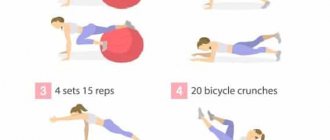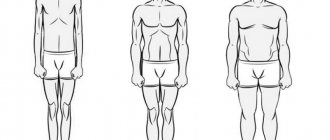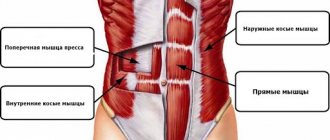Have you ever wondered why only a few of the great number of athletes can boast of washboard abs? But it would seem that training the press is a simple matter: lie down on the floor and go ahead - the more repetitions, the better! Meanwhile, in fact, these endless fidgeting on the floor are more likely to lead to calluses in the nth place than to pump up quality abs.
A real “reinforced concrete” press is the result of a completely different methodological approach, little known among fans of iron sports.
How many reps should you do?
Give up all your dreams of toned abs if you do more than 15 reps in one set. This scheme is ineffective. You will ask why? It's simple. Do you know what fast and slow muscle fibers are? So, your press consists mainly of the former. This means that, due to physiological characteristics, he will respond better to heavy low-repetition sets. While a light load, but a large number of repetitions, will make your muscles “shrink” like those of marathon runners.
For beginners, 15 repetitions is the maximum. Advanced ones should train the abs by adding loads and reducing the number of repetitions down to 6-8 and even 4. The recommended “crunches” for 15 minutes at a time are in the realm of complete idiocy. In short, abdominal training should be the same as training other muscles - hard, intense, but not for long.
How fast does the press pump?
It seems to many that the abs are very different from other muscles, this is due to the fact that they are pumped every day, they are waiting for the quick appearance of abs, in general, they attribute mythical properties to it. But the press is no different from other parts of the muscular system.
Like any other muscles, you won’t be able to pump up your abs quickly. To increase in volume, the abdominal muscles need the same amount of time and energy as the rest. And we know that the process of muscle hypertrophy is slow. Let's briefly touch on physiology.
The first month of training, about 3-5 weeks depending on physical training and body characteristics, the muscles only “learn” to accept the load and adapt to it. Muscles and ligaments become toned during this period. Already from the second month they can adequately respond to the load and recover more easily. During this period, you can increase the intensity of the training, muscle mass will gradually increase. During the first 2-3 months, the muscles take on a beautiful shape, tighten, but increase slightly.
Changing the training scheme
How many times have you heard the phrase “muscles need to be worked through a full range of motion,” but this is precisely what does not happen when you do crunches on the floor or on a bench. And since the amplitude is incomplete, it is impossible to achieve full development of the abdominal muscles.
Where is the way out? It is necessary to change the traditional execution scheme: add resistance and do crunches not on a plane, but on a large ball. Its spherical shape doubles your range of motion! And abdominal training becomes twice as effective. Other abdominal exercises, such as hanging leg raises, also increase range of motion compared to horizontal crunches. True, hanging exercises are aimed mainly at the lower abs.
If you don't have the opportunity to train on a spherical ball, do crunches on an incline bench. But for beginners, it is better to start with regular crunches - on a horizontal surface, and move on to inclined ones gradually, as skills develop.
How quickly do abdominal muscles recover?
All muscles in the body need time to recover after exercise. Training causes muscles to undergo microdamages, which, when restored, contribute to their growth, making them even stronger. For effective growth, it is important to adhere to the principle of supercompensation. This is the period during which the muscles managed to regenerate, but did not lose the ability to train with greater efficiency. For abdominal muscles, this period is about 48 hours. Thus, you can train your abs every other day. The optimal number of abdominal workouts is 3 per week at equal intervals, but no more than 4.
Nuances in abdominal training
Many bodybuilders, even advanced and experienced ones, stick to the same program for months. It is not surprising that their press was “mothballed.” To ensure your progress is constant, consider the following important points.
- Your athletic “foundation” (what sport did you do before bodybuilding). The more comprehensive it was, the faster your body will get used to a particular training program. For example, if you were involved in athletics in high school, your nervous system will be more likely to adapt to a certain set of exercises. That is, you will come to “stagnation” earlier than someone who, before bodybuilding, did not even know what sport was.
- Your experience in bodybuilding (how long have you been pumping iron). The longer you train with weights, the faster you will again adapt to a particular training regimen. Many experienced trainers say that beginners need to change the program every four, advanced athletes every three, and experienced athletes every two weeks.
But what kind of “change” can there be when it comes to training your abs? After all, there are just one or two abdominal exercises and I’ve missed them. Nevertheless, you can successfully diversify your complex. Break the established exercise pattern: vary the number of sets and repetitions, change the load, tempo, rest time. This will be quite enough to stir up the nervous system and give the abs an impetus for further growth.
"Iron" cubes: recommendations
Don’t know how to pump up your abs so that results are quickly noticeable? This must be done with love. At home, we have already discussed how to properly pump up the press, but keep in mind that in the gym, working out with an experienced trainer, the result can be achieved faster. There are many distractions at home: pets, relatives, foreign odors. Therefore, the trainer will get you in shape faster. He will form training plans, taking into account all the physiological nuances.
In the first 2-3 weeks you do not need to go to training for results. Be patient and go to the gym to form a habit. It is difficult for the body to readjust and play sports for pleasure; it needs time. Don’t deceive yourself and admit that it’s impossible to pump up your abs in 7 days. It takes months of hard work.
Get to the point
We offer you a shock method for pumping up the abs, designed for eight weeks. The scheme of exercises, sets and repetitions, tempo of movements, rest time and frequency of training per week are presented in three options - for beginners, advanced and experienced athletes. Choose the option that suits you personally and in two months, believe me, you won’t recognize your abs. One hundred percent guarantee, like in a Swiss bank!
| Complex for beginners | |||||
| Exercises | Sets** | Repetitions*** | Tempo(sec)**** | Rest(min) | Workouts per week |
| Crunches* | 1-3 | 12-15 | 3-0-3 | 1-3 | 2 |
| Pull down with straight arms | 1-3 | 12-15 | 3-0-3 | 1-3 | 1 |
*/ Start with crunches on a horizontal surface. When you can do all the prescribed reps, move to an incline bench.
**/ Start with one set and gradually increase the number to three.
***/ At the initial stage, do exercises with a load that allows you to reach failure at 12-15 repetitions.
****/ The first number is the time of concentric contraction (ascending phase of movement); the second number is the time of isometric (static) contraction, that is, fixation of the position; the third number is the time of eccentric contraction (descending phase of movement).
Note: You must determine the load yourself, it depends on how many repetitions you can perform. If, say, you can only do 10 reps, then the load is too high. If you can do 16 repetitions, then on the contrary, increase the load.
| Complex for advanced | |||||
| Exercises | Sets** | Repetitions*** | Tempo(sec)**** | Rest(min) | Workouts per week |
| Crunches on a block* | 3 | 8-12 | 3-0-3 | 1,5 | 2 |
| Pull down with straight arms | 3 | 8-10 | 2-0-3 | 1,5 | 2 |
*/ Stay within the prescribed number of reps for all sets. If you can't do more than 8, the load is too great; do more than 12, the resistance is too little.
Note: In the advanced stage we add pulley crunches. This exercise will prepare you for a more intense version designed for advanced athletes.
| Complex of experienced | |||||
| Exercises | Sets** | Repetitions*** | Tempo(sec)**** | Rest(min) | Workouts per week |
| Crunches on a block* | 3** | 12-15 | 3-0-3 | 1-1,5 | 2 |
| Incline Bench Crunches | 3 | 8-12 | 3-0-3 | 1 | 2 |
| Pull down with straight arms | 3 | 6-8 | 1-0-3 | 3 | 2 |
*/ Experienced bodybuilders can train with a very heavy load, reducing the number of repetitions to 4. And you can do more sets - up to ten in a complex.
**/ Use the stepped set technique: after failure, reduce the load by about 5-8 kg and continue the set. The number of repetitions in the last, easiest set should not exceed 12-15 times.
Note: Avoid overtraining! Third, do the additional exercise only if you do not have to overcome pain. Pain that prevents you from consistently increasing intensity is the first sign of overtraining.
Why do you want to train your abs every day?
The main reason why people subject themselves to daily training is the desire to achieve noticeable results as quickly as possible. Which one exactly?
● Get rid of fat around the waist, “tuck in” your stomach.
● Pump up your abs, make your stomach flat and sculpted.
None of these problems can be solved by daily abdominal crunches. These are serious goals that are solved comprehensively.
How to remove belly fat
You can show muscle relief on your stomach only if there is no excess fat on it. But it will not be possible to get rid of the latter precisely and quickly. Exercising your abs every day will not give you a fat burning effect!
You can only lose excess weight with comprehensive training. When all the large muscles work, calorie consumption increases, fat melts around the working muscles, including on the stomach. Just try to keep it tight during any exercise.
Should you do abs every day to get rid of belly fat? No. The successful solution of this problem depends 90% on proper nutrition.
How to grow cubes
In order for muscles to grow, you need to not only load them, but also allow them to recover. Then a mechanism called “supercompensation” is triggered in the body. It lies in the fact that the muscle fibers slightly damaged during abdominal training begin to rebuild, but “with a reserve” - so that after renewal they can withstand the increased load.
This process occurs effectively and physiologically if the muscles are given rest. On average, their recovery takes 1-2 days (up to 48 hours).
What happens if you pump up your abs every day? The muscle fibers will not have time to recover. Deprived of rest, they can grow at random, then the increase in muscle mass on the stomach and back will be uneven.
With increasing load, this threatens to thin the muscles around the spine. And the fact that it will cease to perform its “holding” function. There is a risk of getting one of the side effects of an “overdose” of exercise - for example, stooping, intervertebral hernia, displacement.
Who should train the abs and how often?
Is it possible for girls to pump up their abs every day? - No.
Both girls and men are recommended to train no more than three to four times a week, that is, every other day. There is even an opinion that the optimal work schedule for girls is twice a week. Because by pumping your abdominal muscles for no more than 10-15 minutes during a comprehensive workout twice a week, you can avoid waist growth.
Is it possible to quickly pump up abs?
How can you pump up your abs? – With the help of a training plan and proper nutrition.
Strengthening your abdominal muscles is not a quick process. You will see the results of your efforts no earlier than in 8 weeks. The most reliable way to achieve the fastest results is to seek help from a professional trainer.
It will be faster. Because the program compiled by the trainer optimally combines cardio and strength training, taking into account your characteristics (body type, muscle mass, level of physical fitness).
It will be safer. The trainer will teach you the technique of performing exercises to eliminate injuries and the risk of harm to health.
It will be more effective. The trainer will give advice regarding your recovery regimen and nutrition. You can count on him to take a comprehensive view of the situation and stay on track to achieve your goal.
Crunches
Lie on your back on a bench, keeping your legs hanging. Raise your upper body without allowing your lower back to lift off the bench seat. (See the rise time in the “tempo” column). It is better for beginners to keep their hands under their buttocks, for advanced ones – crossed over their chests, for experienced ones – near their ears or, for additional exercise, extended above their heads.
Start the movement using the abdominal muscles, not the neck - do not pull your head forward. Keep it straight, in line with your body, so that your face is facing the ceiling - this will keep your spine in a safe curve in the lumbar region.
Pull down with straight arms
Stand up straight, facing the pulley machine. Grasp the handle of the block with an overhand grip. With full control of the movement, begin to pull the handle down using your abdominal pressure. Maintain the original straight position of your torso - do not let your back round! (See the execution speed in the complexes, in the “tempo” column) Lower the handle as low as possible to the floor, then, under control, return up to the starting position. If you feel that at the start your lower back begins to involuntarily sag, stop the exercise - your abs are already too tired.
Ideally, your feet should be parallel and your toes should be in line. But some bodybuilders prefer to put one foot in front of the other. In this case, with each next set, change the supporting leg.
/Is this really an exercise for the abs?
Usually this exercise is included in back complexes. However, rowing to the bottom with straight arms is also an exercise for the abs and is especially valuable because it is performed while standing. Since we spend most of our active life standing on our feet, the abs need to be worked out not only while lying down or hanging, but also in a standing position. So, abdominal training must include pulling to the bottom.
This exercise gives the abs a unique and unusual load, as it loads it in conjunction with the arms and legs. And the main task of the press in such a tandem is to ensure a neutral position for the pelvis, preventing it from bending back. And this is not very simple, considering that you are moving the load in front of you with outstretched arms.
Also, when the latissimus muscles contract, your pelvis tends to move forward and the abs also need to prevent this. It turns out that throughout the entire exercise, your abdominal muscles are subjected to two loads at once. No amount of twisting will give you such powerful pumping.
Homeschool program for girls
In pursuit of a flat stomach, girls often exhaust themselves with constant abdominal training, not realizing that this muscle needs time to recover, and fat burning does not depend on exercise at all.
Below is a weekly abdominal training program for girls, which is suitable for all ladies who are actively involved in sports:
| Workout #1 | ||
| Ab crunches lying on the floor | 4x15 | |
| Leg raises lying on the floor | 4x15 | |
| Rolling out on a roller for the press | 3x10 |
|
| Elbow plank | 30-60 seconds |
|
| Workout #2 | ||
| Sitap | 4x15 | |
| Running while lying down | 30-45 seconds |
|
| Side plank | 30-60 seconds for each side |
|
| Vacuum | 10 to maximum | |
Another good option for studying at home without any additional equipment:
© artinspiring — stock.adobe.com
Here exercises 1-5 are performed in the 3x10-15 mode.
Recipes for healthy eating
Chicken fillet shish kebab in a frying pan
- 20.4 g Protein
- 1.7 g Fat
- 2.2 g Carbohydrates
- 104.6 kcal
40-60 min.
- #dietary
- #snack
- #green onions
- #corn oil
- #lemon
- #low calorie
- #dinner
- #olive oil
- #snack
- #radish
- #arugula
- #spices
- #dinner
- #apples
- #Apple vinegar
Other recipes
Crunches on a block
Attach a piece of rope or strap to the top pulley, grab it and kneel on the floor, about a meter away from the pulley device. At the beginning of the movement, the back must be straightened to achieve full amplitude. For speed of execution, see the “pace” column of the table of exercise sets. Bend your torso until your abdominal muscles are fully contracted (until your elbows touch your thighs)
/Why are there so few repetitions?
We have already described above that training the abs with more than 15 repetitions per set will pump it up very weakly, since it will receive almost no real power load. You will only load the slow type of muscle fibers, which have a significant effect on endurance, but not on strength and muscle mass. Do you feel the difference?
If you want to see six-pack abs while getting strong abs, your sets should be 8-12 reps. To do this, use a weight in the form of a dumbbell or a barbell plate. But don’t overdo it, with weights you should clearly fit into the framework described above and reach failure within this interval. This will force the abdominal muscles to work in strength mode, which will make the workout much more effective.
Abdominal exercises: useful tips
When it comes to questions about how many times a day you can pump your abs, and many others, experts give us the following recommendations:
- The rate of muscle growth does not depend so much on the number of repetitions of exercises. The result of 4 sets of 20 reps will be the same as 80 reps performed continuously, but it will exhaust you greatly.
- Remember the fat layer. If it is there, it will have to be removed using a special diet.
- The success of the workout will be indicated by a pleasant burning sensation in the abdomen. It indicates that the process of muscle growth has begun.
- The technique of doing the exercises is important. Only the right approach to them will help achieve results without harm to health.
- To prevent the muscles in the abdominal cavity from getting used to the load, you need to periodically change the exercises you perform. It is also important to alternate the work of the oblique abdominal muscles and the rectus muscle, working on both the upper and lower abs.
To achieve results, you need the right approach to exercise combined with proper nutrition. Also remember that you need to periodically increase the load - add exercises or approaches, because over time the same program will cease to be effective.
How long does it take to pump up your abs?
Ball advantage
Most bodybuilders do their abs by lying on a flat surface and curling forward. But in this way, the abs are worked out with a limited range of motion. To expand it, a large spherical ball is ideal. Physiotherapists use these balls to rehabilitate patients after spinal injuries.
The abdominal muscles must ensure stability of the spine during any movements of the torso: extension, flexion, rotation from side to side. That is why it is important to work out the abs with maximum amplitude, and the spherical shape of the ball will help you with this.
One important point: the ball is an unstable projectile, training on it requires special neuromuscular tension. Therefore, you can only do crunches on a ball if you have solid athletic training and are in good shape. To increase the load, you can do the exercise with a dumbbell on your chest. At the same time, stay within the prescribed number of repetitions.
5 1 vote
Article rating
How many approaches to do until failure?
You can only go to failure on one set of each exercise once every two weeks. Although, according to most experts, excluding this type of “failure” from training will not in any way affect the effectiveness of the training.
Interesting materials:
How to add another founder to an LLC? How to whiten tulle? How to whiten things? How to choose shrimp? How to choose a sink for the kitchen? How to choose curtains and tulle? How to get out of a debt hole in Ukraine? How to clean white sneakers? How to clean a sofa from stains? How to remove scale from a kettle?











